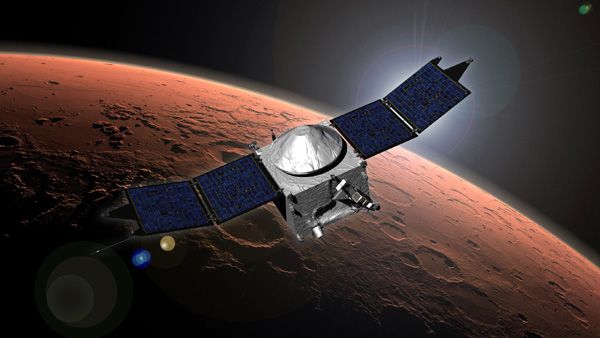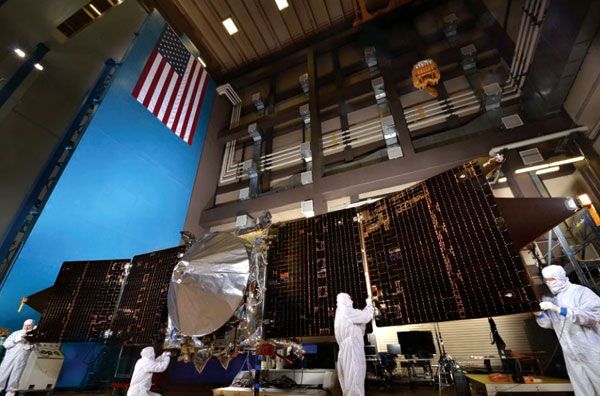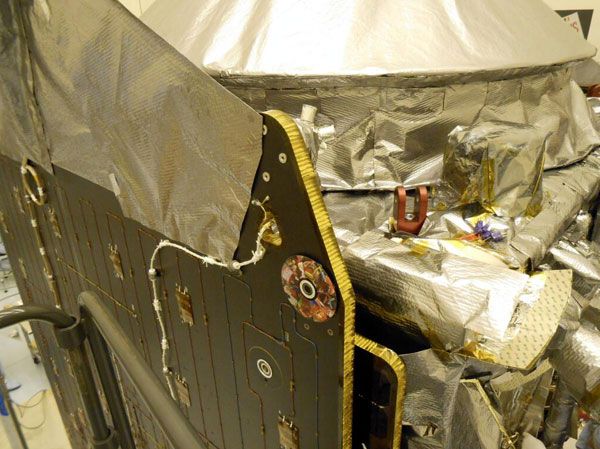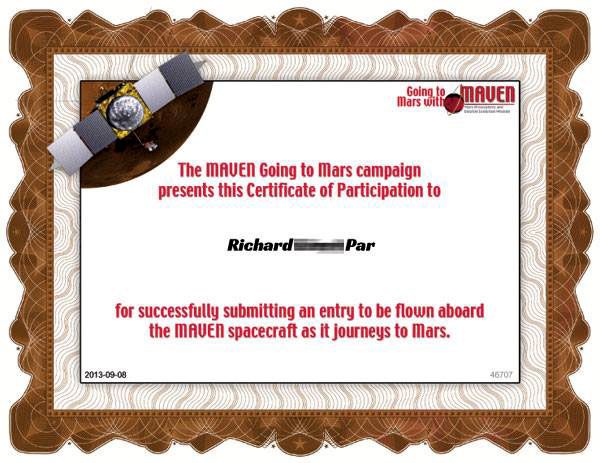
NASA
NASA’s Newest Mars Mission Spacecraft Enters Orbit around Red Planet (Press Release)
NASA’s Mars Atmosphere and Volatile Evolution (MAVEN) spacecraft successfully entered Mars’ orbit at 10:24 p.m. EDT Sunday, Sept. 21, where it now will prepare to study the Red Planet’s upper atmosphere as never done before. MAVEN is the first spacecraft dedicated to exploring the tenuous upper atmosphere of Mars.
“As the first orbiter dedicated to studying Mars’ upper atmosphere, MAVEN will greatly improve our understanding of the history of the Martian atmosphere, how the climate has changed over time, and how that has influenced the evolution of the surface and the potential habitability of the planet,” said NASA Administrator Charles Bolden. “It also will better inform a future mission to send humans to the Red Planet in the 2030s.”
After a 10-month journey, confirmation of successful orbit insertion was received from MAVEN data observed at the Lockheed Martin operations center in Littleton, Colorado, as well as from tracking data monitored at NASA’s Jet Propulsion Laboratory (JPL) navigation facility in Pasadena, California. The telemetry and tracking data were received by NASA’s Deep Space Network antenna station in Canberra, Australia.
“NASA has a long history of scientific discovery at Mars and the safe arrival of MAVEN opens another chapter,” said John Grunsfeld, astronaut and associate administrator of the NASA Science Mission Directorate at the agency’s Headquarters in Washington. “MAVEN will complement NASA’s other Martian robotic explorers—and those of our partners around the globe—to answer some fundamental questions about Mars and life beyond Earth.”
Following orbit insertion, MAVEN will begin a six-week commissioning phase that includes maneuvering into its final science orbit and testing the instruments and science-mapping commands. MAVEN then will begin its one Earth-year primary mission, taking measurements of the composition, structure and escape of gases in Mars’ upper atmosphere and its interaction with the sun and solar wind.
"It's taken 11 years from the original concept for MAVEN to now having a spacecraft in orbit at Mars,” said Bruce Jakosky, MAVEN principal investigator with the Laboratory for Atmospheric and Space Physics at the University of Colorado, Boulder (CU/LASP). “I'm delighted to be here safely and successfully, and looking forward to starting our science mission."
The primary mission includes five “deep-dip” campaigns, in which MAVEN’s periapsis, or lowest orbit altitude, will be lowered from 93 miles (150 kilometers) to about 77 miles (125 kilometers). These measurements will provide information down to where the upper and lower atmospheres meet, giving scientists a full profile of the upper tier.
“This was a very big day for MAVEN,” said David Mitchell, MAVEN project manager from NASA’s Goddard Space Flight Center, Greenbelt, Maryland. “We’re very excited to join the constellation of spacecraft in orbit at Mars and on the surface of the Red Planet. The commissioning phase will keep the operations team busy for the next six weeks, and then we’ll begin, at last, the science phase of the mission. Congratulations to the team for a job well done today.”
MAVEN launched Nov. 18, 2013, from Cape Canaveral Air Force Station in Florida, carrying three instrument packages. The Particles and Fields Package, built by the University of California at Berkeley with support from CU/LASP and Goddard contains six instruments that will characterize the solar wind and the ionosphere of the planet. The Remote Sensing Package, built by CU/LASP, will identify characteristics present throughout the upper atmosphere and ionosphere. The Neutral Gas and Ion Mass Spectrometer, provided by Goddard, will measure the composition and isotopes of atomic particles.
MAVEN's principal investigator is based at CU/LASP. The university provided two science instruments and leads science operations, as well as education and public outreach, for the mission. The University of California at Berkeley's Space Sciences Laboratory also provided four science instruments for the mission. Goddard manages the MAVEN project. Lockheed Martin built the spacecraft and is responsible for mission operations. JPL provides navigation and Deep Space Network support, as well as Electra telecommunications relay hardware and operations.
Source: NASA.Gov
****

NASA / Lockheed Martin

NASA


No comments:
Post a Comment